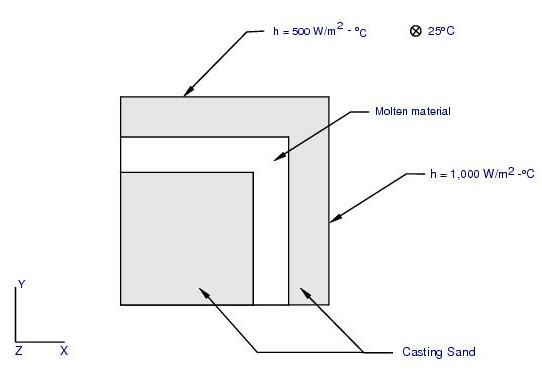XXXXXXXXXXXXXXXXXXXXXXXXXXXXXXXXXXXXXXXXXXXXXXXXXXXXXXXXXXXXXXXXXXXXXXXXXXXXXXXXXXXXXXXXXXXXXXXXXXXXXXXXXXXXXXXXXXXXXXXXXXXXXXXXXXXXXXXXXXXXXXXXXXXXXXXX''"> Example Problem Number 8--Sample of User Routines
Introduction
Example problem 8 will demonstrate a sample of a Patran Thermal analysis utilizing user supplied subroutines in the context of a 2-D transient analysis.
Goal
This exercise will familiarize the new user with the steps required to define the appropriate files and boundary conditions for a Patran Thermal analysis involving user supplied subroutines.
Given
A section of square tubing is cast in a moist sand mold. A quarter symmetry model is developed. The casting is poured in a room which is maintained at 25 degrees C. Ignore all risers and end effects and use a 2-D model to represent the thermal problem. Assume perfect contact between the casting material (material number 351) and the molding sand (material number 831). The casting material has an initial temperature of 1600 degrees C. Heat is lost to the ambient environment at a constant heat transfer coefficient of 500 W/m2-°C on all horizontal surfaces and 1000 W/m2-°C on all vertical surfaces.
The molding sand has an initial moisture content of 40 kg/m3 which can be vaporized. As it is vaporized, it is assumed to be lost out the casting. For this exercise, only capture the energy absorbed in the fluid as it is heated up and vaporized. Do not model any effects of the vapor flowing through the mold and treat those areas that are above the vaporization temperature initially, the same as if it were going through a heat up cycle. Continue to absorb energy until all the moisture has been driven from the sand.
Perform a transient analysis for at least 500 seconds.
Note: | You will need to compile the fortran subroutines, umicro.f and uloop7.f located in the subdirectory prob8a. This is done with the command:
% ulib uloop7.f
% ulib umicro.f |
Figure D‑8 Example Problem 8 - Sample of a QTRAN Analysis

